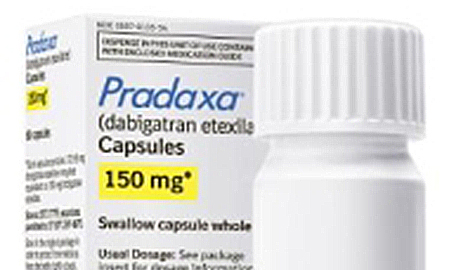Blockbuster blood-thinner Pradaxa will come under scrutiny again, it appears. The FDA announced last Friday that it has established a study to evaluate post-trial safety outcomes in blood-thinning treatments warfarin and Pradaxa (dabigatran), via its Mini-Sentinel initiative, part of the regulators’ surveillance system.
FDA had stated in a November 2012 report that bleeding rates associated with Pradaxa were no higher than with warfarin. Despite that, the Boehringer Ingelheim drug, approved in 2010 to prevent stroke in patients with atrial fibrillation, has faced persistent safety concerns over anticoagulant bleeding rates and, specifically, the absence of an antidote for the agent’s clotting prevention.
But the decision to put Pradaxa under the microscope again has at least one doctor scratching his head. “I don’t know why the FDA is doing another review, since the Mini-Sentinel evaluation showed the rate of bleeding post-marketing to be similar to what was seen in the RELY trial,” Randall Zusman, MD, a Harvard cardiologist, told MM&M today by e-mail.
“To get the marked reduction of ischemic stroke, you have to accept more GI bleeds. It’s really as simple as that,” added Dr. Zusman, who is associate professor of medicine at Harvard Medical School and director of the division of hypertension at Mass General Hospital’s Institute for Heart, Vascular and Stroke Care. “I would predict a review of new users will show dabigatran in a positive light.”
There are over 2,000 lawsuits pending litigation in Illinois, according to New York-based law firm Bernstein Liebhar, accusing BI of failing to provide adequate warnings regarding “the risk of Pradaxa bleeding.” Pradaxa saw $811 million in sales for the first half of 2013.
The latest FDA analysis could suss out the risk. However, FDA noted as a disclaimer to the study that “the fact that FDA requests and receives data on a particular product through Mini-Sentinel does not necessarily mean there is a safety issue with the product.”
Regulators stated that it will be a one-time evaluation of “selected safety outcomes in adults with atrial fibrillation who are new users of dabigatran or warfarin” and that the objective of the analysis will be to “assess systematically the rates of bleeding and thromboembolic outcomes associated with the use of dabigatran and warfarin for patients with atrial fibrillation.”
The agency also noted that the rates of major intracranial bleeding were lower for Pradaxa than warfarin, but that Pradaxa’s rate of major gastrointestinal bleeding was higher than that of warfarin.
FDA cited the aging of the Baby Boomers and rising prevalence of risk factors such as hypertension, diabetes and heart failure in the US as the primary cause of concern, and that “in all, atrial fibrillation will continue to increase rapidly with an estimated 6-12 million by 2050.”
While the document addresses the fact that bleeding rates for dabigatran and warfarin were “similar,” it says that there are still questions on “outcomes associated with the use of dabigatran and warfarin outside of the clinical trial setting and in typical clinical practice populations.” The study will evaluate new users of either drug.
There are currently no listed studies on the FDA’s website that says it will be assessing the safety of other oral anticoagulants, like Johnson & Johnson’s Xarelto, or Pfizer and Bristol-Myers Squibb’s Eliquis.
Forbes reported from a “knowledgeable source” that the primary objective of the study will be to assess high-risk groups of patients.
As of Tuesday morning, BI provided MM&M with a response to the review. “The protocol provides rationale for the focus of the FDA’s assessment on dabigatran, noting that the use of other alternative anticoagulants (e.g., rivaroxaban or apixaban) is ‘expected to be too uncommon for an adequately powered analysis during the assessment period.'”
The drugmaker also reiterated the regulator’s previous rulings: “Previous assessments from the Mini-Sentinel pilot, which were published in November 2012 and April 2013, found that bleeding rates associated with new use of Pradaxa do not appear to be higher than those with new use of warfarin, a finding that is consistent with observations from the pivotal RE-LY trial. To date, the FDA has not changed its recommendation regarding the use of Pradaxa in the population for which it is approved. Pradaxa provides an important health benefit when used as directed to reduce the risk of stroke and systemic embolism in patients with non-valvular atrial fibrillation.”
The Mini-Sentinel Operations Center will accept public comments on the study through Jan. 13.








